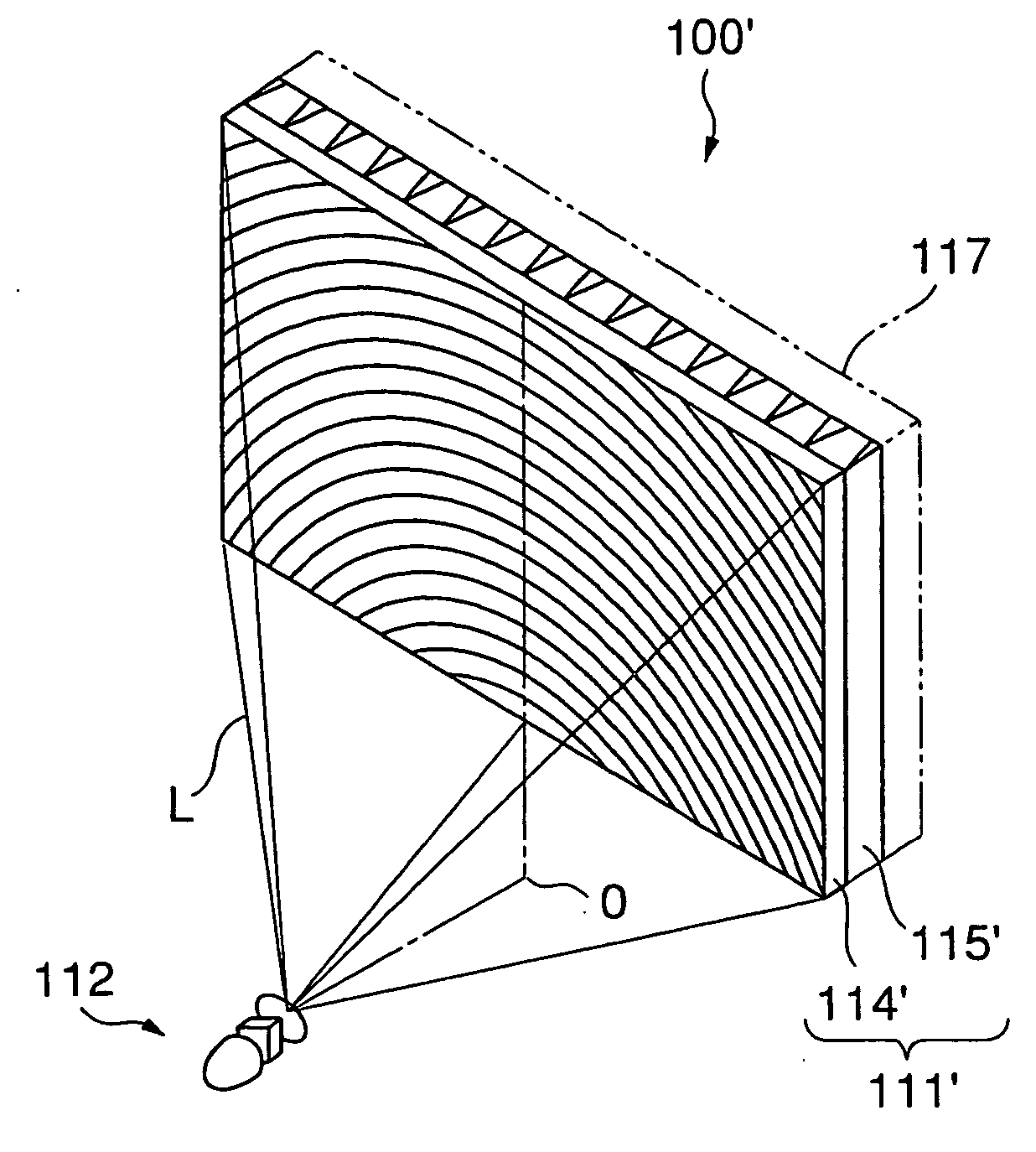Projection screen and projection display device
a projection screen and display device technology, applied in the field of projection screens, can solve the problems of difficult mold making of unit prism molds, image light loss, and inability to reduce, so as to reduce surface brightness or contrast, increase the allowable angle of incidence, and increase the apical angle. the effect of angl
- Summary
- Abstract
- Description
- Claims
- Application Information
AI Technical Summary
Benefits of technology
Problems solved by technology
Method used
Image
Examples
first embodiment
First of all, a projection screen according to the first embodiment of the present invention and a projection display comprising it will be described with reference to FIGS. 1 to 10.
As shown in FIG. 1, a projection display 100 according to the first embodiment of the present invention comprises a projection screen 111 and a projection optical system 112 from which imaging light L is obliquely projected on the projection screen 111. The projection optical system 112 comprises an imaging light source composed of an LCD, DMD, or the like, and an optical system for spreading the imaging light emitted from the imaging light source.
The projection screen 111 is for letting imaging light L obliquely projected from the projection optical system 112 placed at its rear side emerge toward the viewer's side, and comprises a total reflection prism lens 114, and a lenticular lens 115 provided on the viewer's side of the total reflection prism lens 114.
Of these components, the total reflecti...
first modification
(First Modification)
The above embodiment has been described with reference to the case where the apical angles λ of the unit prisms 113 are varied continuously over the entire screen plane. The present invention is not limited to this, and the apical angles λ of the unit prisms 113 may also be varied step-wise within the screen plane.
The first modification of the projection screen 111 shown in FIGS. 1 to 5 will be described with reference to FIGS. 6A, 6B, 7 and 8. Since the basic construction of this first modification is the same as that of the projection screen 111 shown in FIGS. 1 to 5, emphasis is, in the following description, laid on those points distinct from the projection screen 111 shown in FIGS. 1 to 5.
FIG. 6A is a view of a projection screen 111 according to the first modification, viewed from the incident side of the screen, and FIG. 6B is a view of the projection screen 111 according to the first modification (and a projection optical system 112), viewed from the s...
second modification
(Second Modification)
Next, the second modification of the projection screen 111 shown in FIGS. 1 to 5 will be described with reference to FIGS. 9A, 9B and 10. The second modification is a further modification of the above-described first modification, which can further ensure that the variation in the apical angle λ of each unit prism is not perceived. Since the basic construction of the second modification is the same as that of the first modification described above, emphasis is, in the following description, laid on those points distinct from the first modification.
FIG. 9A is a view of a projection screen 111 according to the second modification, viewed from the incident side of the screen, and FIG. 9B is a view of the projection screen 111 according to the second modification (and a projection optical system 112), viewed from the side of the screen.
As shown in FIGS. 9A and 9B, the projection screen 111 comprises a total reflection prism lens 114B having a plurality of unit p...
PUM
 Login to View More
Login to View More Abstract
Description
Claims
Application Information
 Login to View More
Login to View More - R&D
- Intellectual Property
- Life Sciences
- Materials
- Tech Scout
- Unparalleled Data Quality
- Higher Quality Content
- 60% Fewer Hallucinations
Browse by: Latest US Patents, China's latest patents, Technical Efficacy Thesaurus, Application Domain, Technology Topic, Popular Technical Reports.
© 2025 PatSnap. All rights reserved.Legal|Privacy policy|Modern Slavery Act Transparency Statement|Sitemap|About US| Contact US: help@patsnap.com



